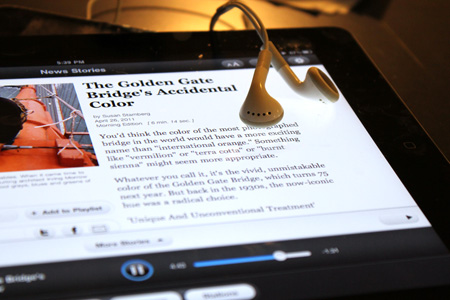
NPR’s iPhone, iPad, and Android apps have together surpassed five million downloads, an impressive number — but most of their users never stream audio. When they do listen, however, they are far more engaged.
According to NPR’s internal usage data covering January 1 through mid-April, users who request audio — maybe a station stream, a national newscast, or NPR Music content — view twice as many pages as those who only read the apps’ content. On average, audio streamers rack up 4.2 pageviews per visit versus 2.4 for the text-only crowd. (“Pageviews” in this case refers only to news content, not navigation pages.) The ratio holds up for iPad users, too: Listeners view 8.1 pages per visit, versus 3.9 among readers.
The numbers for Android are lopsided — 94 percent of those users have not used audio — but that is probably because the app was impaired by technical problems that were only recently resolved, Sondra Russell, NPR’s web metrics analyst, told me. The younger Android app, unveiled in late 2009, also has fewer users, she said — about 900,000 downloads to date versus 2.6 million for the iPhone version.
But here’s another stat: The vast majority of iPhone visits, 60 to 70 percent, do not involve audio. (“Visits” are different from “visitors” — one visitor can visit an app multiple times a day, perhaps to check the latest headlines.) Fewer than half of NPR’s iPhone users listened to audio inside the app during the January to April period.
And that discrepancy is by design. “I don’t see the usage patterns as a problem,” Kinsey Wilson, NPR’s general manager of digital media, told me in an email. “In fact, we made a conscious decision to position our (written) news coverage prominently in our mobile applications because we wanted people to think of us as a comprehensive and up to the minute source of news, not simply a source of radio listening.”
Radio listening can be an active or passive activity, Wilson noted, a true multitasking medium — and the usage numbers reflect that. Overall, he said, they suggest that “we’re capturing both casual and intensive news consumers.”
Also embedded in the usage data are encouraging numbers for NPR member stations, many of whom worry about a problem called “bypass” — that is, the idea that listeners will go straight to NPR for online listening, bypassing the station itself. It turns out that half the people who use NPR’s apps for audio are listening to local streams — and between 10 and 15 percent of users launch the app just to play a station stream and do nothing else. “We’ve gotten no pushback either from stations or the users,” Wilson said.
It’s important to note that engagement on apps isn’t (exactly) the same as engagement online. NPR doesn’t measure the app equivalent of the “time on site” metric, Russell said, because the numbers tend to be “wildly inaccurate”: It’s hard to know when a user is switching out of the app for just a moment to check e-mail, for example, or when that user clicks the phone’s “home” button but leaves the app running in the background.
Still, though, NPR’s stats suggest promising trends not just for its user engagement, but also for the business side of user loyalty. A new survey of 2,100 adults with broadband connections, commissioned by the Internet radio ad network TargetSpot, found that Internet radio listeners were twice as likely to respond to an ad — by clicking it, “liking” the company on Facebook, searching the web for additional information about it, or purchasing a product — than were ordinary web surfers. And listeners, even casual ones, were more likely to recall ads after exposure to them. For NPR, and for any news outlets with audio content to offer, those could be findings worth listening to.
Image by Andrew Phelps.